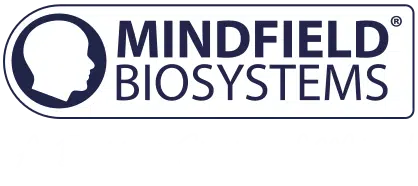
Body and skin temperature explanation
What is temperature biofeedback training?
In temperature biofeedback, skin temperature is used as the feedback variable. The temperature is measured constantly and changes are recorded and analysed. The autonomic nervous system exerts a direct influence on skin temperature. Therefore, the activity of the skin can also be inferred from the skin temperature. This, in turn, is exactly the basis needed for biofeedback.
Background knowledge on skin temperature

The temperature at the surface of the skin changes depending on how much blood is flowing through the tissue. Fine blood vessels (arterioles) run through the tissue and are surrounded by fibres of the smooth muscles, which are controlled by the sympathetic nervous system.
In a state of increased tension or excitement (stress), these muscles contract and the blood vessels narrow. The skin temperature drops because the tissue is less supplied with blood. In a relaxed state, on the other hand, these muscles relax, which causes the blood vessels to dilate and the skin temperature to rise.
A conscious increase in skin temperature is therefore directly associated with a state of being stress-free and relaxed. This mechanism can be practised with a biofeedback device such as the eSense Temperature.
Skin temperature biofeedback is simple to use and easy to learn. This shows a high success rate and an improvement in general well-being.
The body also uses the skin temperature to adjust the internal body temperature. It regulates the release of heat through the skin, both via blood circulation and via the activity of the sweat glands. Closely related to these regulatory mechanisms is, for example, sweating under fear or anger.
Why not use the core body temperature?
On the one hand, it almost does not change; the body always keeps it as constant as possible at the right value. On the other hand, it is much harder to measure.
Hand warming training in practice with the eSense Temperature
A particularly effective and frequently used biofeedback training method is “hand warming training”. During hand warming training you learn to specifically increase the blood circulation in your hands, which directly leads to stress reduction and relaxation.
The eSense gives the user precise feedback on the current stress level in a variety of forms, e.g. through measurement curves, diagrams, video and audio displays.
Take 10 minutes (or more) for a training session. You can sit down comfortably. Just try to relax and observe how their temperature responds. Getting started with this training is very easy for most users.
However, a lot happens even in a short unit. One of the great benefits of this biofeedback training is that you gain an expanded awareness of your body. They automatically start to be more aware of body temperature. This also gives you at the same time a good self-awareness and a feeling for your “inner psychosomatic interplay”. With the hand warming training you thus use already existing mechanisms of the body to reduce stress, which you activate via the feedback.
The biofeedback device, in this example the eSense Temperature, records everything in the background and automatically creates statistics that record all changes in temperature over time. You can also note down how you feel after each measurement, this can be interesting especially over a longer period of time. With all eSense products, you can also export your measurements as a CSV file if required and process them further with Excel or other programmes, for example.
You can get the eSense Temperature in our shop.
How well can skin temperature training be incorporated into everyday life?
Mobility during training
In skin temperature training there is usually only one sensor. It is held in the hand. Often you can simply hold it with two fingers, so accordingly a cable leads from your hand to the smartphone or tablet. You are minimally restricted in your movement by both the cable and the sensor on your hand. Otherwise, you can move freely, use your body well during training. Secure the sensor with a plaster, Velcro or finger clip so that you do not have to hold it all the time.
Depending on the training method, you will need to apply a different level of concentration. This is definitely the biggest limitation, the constant feedback will keep the training slipping to the forefront of their minds. Therefore, it is recommended to have training times when you are doing nothing or hardly anything else. Many simple, very routine activities that are rather quiet are excellent for biofeedback training. A good example is taking the bus or train every day, a very good opportunity to have a training session. Not being completely abstinent from external influences can also be an advantage.
Costs
The cost of skin temperature feedback depends on the provider and device. As an example, our eSense Temperature is an affordable single investment, designed specifically for the private home user. So you don’t have a trained coach to guide you, but an app that you can follow yourself. This has advantages and disadvantages. Eine professionelle, begleitende Ausbildung ist in der Regel teurer. Training at home with your own equipment is usually a lot cheaper and you can fit it into your daily routine better.
Frequency and home use
You should do the training several times a week to several times a day. The exact frequency depends on many factors. The number of sessions needed for reliable success is relatively low compared to other biofeedback trainings. Usually 6 to 10 sessions are enough for the first significant successes. As for the duration of a session, this depends on your ability to concentrate, but should not exceed 30 minutes. If there are strong signs of fatigue, the training should be shorter and a higher number of sessions should rather be chosen.
You have a lot of freedom in how you use home appliances. This allows you to integrate the positive results of skin temperature biofeedback into your daily life without getting into planning difficulties. Many other methods of addressing similar symptoms require much more rigorous planning. With biofeedback you usually enjoy more freedom.
What are the temperature parameters?
Temperature is primarily measured in degrees Celsius (°C) in the case of skin and body temperature. However, other temperature scales are also possible. So you can also switch to Fahrenheit in our eSense app. In humans, the normal core body temperature is between 36.3 and 37.4 °C. The skin temperature is colder and depends very much on the current state of exertion as well as the outside temperature. Since temperature fluctuations are in the range of a few tenths of a degree Celsius, it is important that temperature sensors work very accurately and register even the smallest changes quickly and reliably. Therefore, the heat capacity of the sensor must be small, which is one of the reasons why sensors have become so small. A lot of mass would also lead to a high heat capacity, and only slow fluctuations in temperature would be perceived. Especially for biofeedback, it is important to measure and evaluate every change immediately. Every person is different, so both the underlying temperatures but also change values are individual. Good software must be able to correctly assess these differences.
Temperature and sweat
Via evaporative cooling, the body tries to generate increased heat dissipation with sweat production. As a general rule, the greater the temperature difference between the skin and the air, the more heat is released. In addition to this gradient, heat transport functions via evaporating water, sweat. The body can also regulate the release of heat through blood flow, increased blood flow leads to increased skin temperature. Do not exercise when you are sweating or cold, first create a comfortable environment and body temperature. Usually this means 20-24 °C room temperature.
